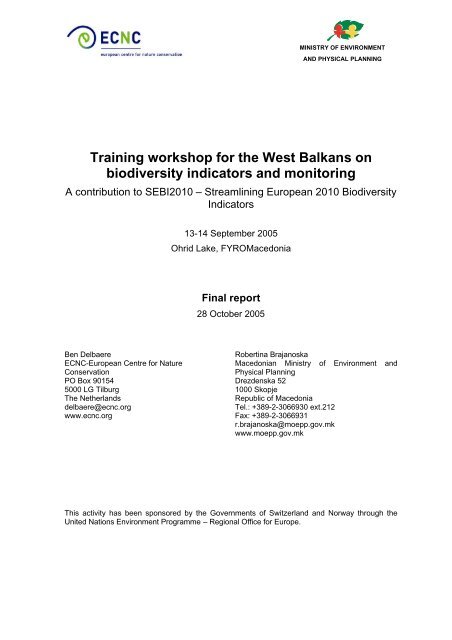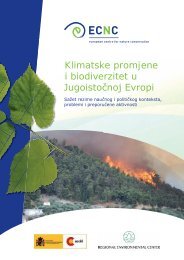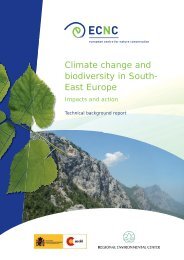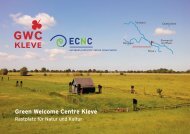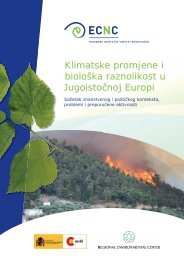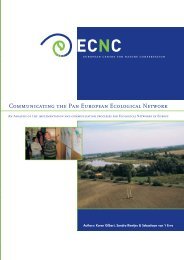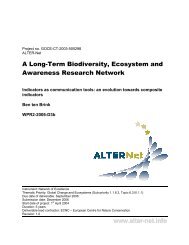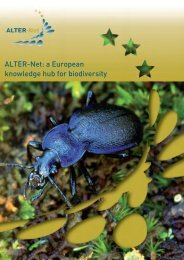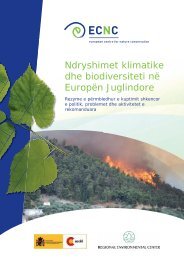Balkan training workshop report.pdf - ECNC
Balkan training workshop report.pdf - ECNC
Balkan training workshop report.pdf - ECNC
Create successful ePaper yourself
Turn your PDF publications into a flip-book with our unique Google optimized e-Paper software.
MINISTRY OF ENVIRONMENTAND PHYSICAL PLANNINGTraining <strong>workshop</strong> for the West <strong>Balkan</strong>s onbiodiversity indicators and monitoringA contribution to SEBI2010 – Streamlining European 2010 BiodiversityIndicators13-14 September 2005Ohrid Lake, FYROMacedoniaFinal <strong>report</strong>28 October 2005Ben Delbaere<strong>ECNC</strong>-European Centre for NatureConservationPO Box 901545000 LG TilburgThe Netherlandsdelbaere@ecnc.orgwww.ecnc.orgRobertina BrajanoskaMacedonian Ministry of Environment andPhysical PlanningDrezdenska 521000 SkopjeRepublic of MacedoniaTel.: +389-2-3066930 ext.212Fax: +389-2-3066931r.brajanoska@moepp.gov.mkwww.moepp.gov.mkThis activity has been sponsored by the Governments of Switzerland and Norway through theUnited Nations Environment Programme – Regional Office for Europe.
Biodiversity monitoring <strong>training</strong> <strong>workshop</strong> <strong>report</strong>1 BackgroundOver the last years the interest in monitoring trends in biodiversity has increased, both politicallyand in science and society. International commitments have been agreed at global level (set ofheadline indicators by the CBD), pan-European level (Kyiv Resolution on Biodiversity, target 8 onindicators and monitoring) and EU level (EU headline biodiversity indicators).In 2004 a pan-European process started to support the implementation of the pan-European andEU biodiversity indicators. This process, Streamlining European 2010 Biodiversity Indicators(SEBI2010), builds on the European Biodiversity Monitoring and Indicator Framework (EBMI-F)that was launched in 2001 under the PEBLDS process. SEBI2010 covers pan-Europe as well asEU and has close links to PEBLDS. It has become the key process in helping to achieve the KyivTarget 8.The SEBI2010 process is coordinated by the European Environment Agency (EEA), EuropeanCentre for Nature Conservation (<strong>ECNC</strong>) and UNEP World Conservation Monitoring Centre (UNEP-WCMC). Expert groups have been established to document six of the 15 EU headline biodiversityindicators during 2005. More details on SEBI2010 can be found on http://biodiversitychm.eea.eu.int/information/indicator/F1090245995.A joint meeting of EIONET (European Environmental Information and Observation Network), IWGBio-MIN (International Working Group on Biodiversity Monitoring and Indicators) and PEBLDS on21-23 April 2004 was held at the EEA (http://biodiversitychm.eea.eu.int/information/indicator/F1078143615).This Joint meeting formed the basis forestablishing SEBI2010. A kick-off meeting of SEBI2010 was organized at the EEA on 5-6 January2005, with some 70 participants representing most of the countries of the Pan-European region aswell as a number of international organizations.During the joint meeting and the kick-off meeting it was observed that participation from the‘western <strong>Balkan</strong>’ (the 5 <strong>Balkan</strong> countries that are not members of the EEA) was relatively passive,accept for the FYROMacedonia. Because SEBI2010 is a pan-European effort, covering allPEBLDS countries, it was considered that this region needed some stimulus for increasedparticipation.2 Training <strong>workshop</strong>2.1 ObjectivesBased on its experience with holding a <strong>training</strong> <strong>workshop</strong> on ecological networks, stakeholderparticipation and monitoring in Croatia in 2004 (the CRO-NEN project, www.cro-nen.hr) the <strong>ECNC</strong>proposed to hold a <strong>training</strong> <strong>workshop</strong> focusing on biodiversity indicators and monitoring in thewestern <strong>Balkan</strong> region. The aim of the <strong>workshop</strong> was to encourage the participating countries(Albania, Bosnia and Herzegovina, Croatia, FYROMacedonia, and Serbia and Montenegro) tomore actively participate in the pan-European SEBI2010 process, to share information aboutinternational and national biodiversity indicator and monitoring initiatives, and to help build theircapacity in developing national biodiversity monitoring programmes.2.2 Workshop set-upThe Governments of Switzerland and Norway provided financial support to the proposal throughthe UNEP Regional Office for Europe. The <strong>ECNC</strong> coordinated the project, developed a <strong>training</strong>agenda and supporting material and led the <strong>training</strong> towards developing an outline for a nationalbiodiversity monitoring programme. The Macedonian Ministry of Environment and PhysicalPlanning (MOEPP) was the regional contact for the project, helped identify the potential meetingparticipants per country, ensured the initial contact with the participants, and hosted the <strong>workshop</strong>in a hotel at the Lake Ohrid, west-Macedonia.<strong>ECNC</strong>, 28/10/05 2
Biodiversity monitoring <strong>training</strong> <strong>workshop</strong> <strong>report</strong>2.3 ParticipantsFrom all five countries about four participants were invited to the <strong>workshop</strong>. The total number ofparticipants was limited to 20 in order to allow sufficient interaction and informality. Invitees wereselected by MOEPP and <strong>ECNC</strong> on the basis of contact through the PEBLDS representation,involvement in CBD activities or in biodiversity monitoring in particular. The participantsrepresented a good range of organizations, including government authorities, research institutes,and academia. Unfortunately, the week before the <strong>workshop</strong> the only representative of Bosnia andHerzegovina cancelled participation. The full participants list is included in Annex 1.2.4 AgendaThe <strong>workshop</strong> lasted for two days. The first day was largely devoted to providing information aboutsome background concepts and terminology on biodiversity indicators and monitoring, internationalpolicy and processes and national examples. This day had a lecturing style. Ben Delbaere, <strong>ECNC</strong>,gave most of the presentations. Ms Ramona Topic gave a presentation on the Croatianexperiences in the CRO-NEN project. Dr Sreten Andonov from Macedonia provided a perspectiveon genetic biodiversity.The five examples from ongoing national biodiversity monitoring programmes included:1. Switzerland: Biodiversity Monitoring Switzerland – BDM-CH2. the Netherlands: Network Ecological Monitoring – NEM3. Hungary: Hungarian Biodiversity Monitoring System – HBMS4. Bulgaria: National Biodiversity Monitoring System – NBMS5. Croatia: Croatian Ecological Network – CRO-NENOn day two four working groups were formed, with a mixed representation of each country in orderto prevent each country to discuss what was already known. The working groups were given thetask to spend the morning on a list of basic questions that helped them think about developing anational biodiversity monitoring programme. In the afternoon the working groups presented theiroutcome and a plenary discussion led to a joint understanding of the key issues in developing anational biodiversity monitoring programme.The results of the working groups were incorporated into an outline national monitoringprogramme, which also included summarizing statements.The meeting agenda is included in Annex 2.2.5 OutcomeThe <strong>training</strong> <strong>workshop</strong> led to the following results:• There is increased awareness among the participants about international developments inbiodiversity indicators and monitoring in general and about the Kyiv Target 8 andSEBI2010 in particular.• Participants are encouraged to more actively engage in the SEBI2010 process by sharingexpertise and ensuring a connection between the European process and the nationaldevelopments.• Participants learned from each other’s experiences in biodiversity monitoring at thenational level. It was clear to all that much more is happening in the four participatingcountries than was originally perceived.• The participants developed jointly with the trainer an outline for developing a nationalbiodiversity monitoring programme. This outline consists of key issues and attention pointsand it is advised that this be used as a dynamic guidance for national developments.• Although not explicitly on the agenda, some bottlenecks have been identified, includinglack of funds, lack of volunteers, lack of data infrastructure, lack of priority by decision<strong>ECNC</strong>, 28/10/05 3
Biodiversity monitoring <strong>training</strong> <strong>workshop</strong> <strong>report</strong>makers, and physical constraints of the countries (e.g. remoteness or inaccessibility ofareas that need to be monitored).The outline for a national biodiversity monitoring programme that resulted from the meeting isincluded in Annex 3.3 Follow upThe <strong>training</strong> <strong>workshop</strong> provided a first step in a process of encouraging the western <strong>Balkan</strong> regionto more actively participate in the SEBI2010 process and, where appropriate, it provided someguidance for the development of a national biodiversity monitoring programme.It would be recommendable that follow-up steps help in moving towards implementation of nationalbiodiversity monitoring programmes. Logical next steps include national specification of the generalguidance that has been provided in the <strong>workshop</strong>, matching the EU headline biodiversity indicatorswith national indicators, identification of bottlenecks and possible solutions, exchange ofexperiences between countries of the region and with other countries in Europe, and increasingadoption, recognition and funding of biodiversity monitoring.Possible follow-up steps regarding the link with SEBI2010 may include targeted communicationabout the process and outcome to and within the region, increased regional dialogue (e.g. bysetting up a regional SEBI2010 platform), and continued financial support for participation inSEBI2010.<strong>ECNC</strong>, 28/10/05 4
Biodiversity monitoring <strong>training</strong> <strong>workshop</strong> <strong>report</strong>Annex 1: List of participantsSreten AndonovFaculty of Agricultural Sciences and FoodPO Box 2971000 SkopjeRepublic of MacedoniaTel.: +389-2-3115277 ext. 263Fax: +389-2-3134310sandonov@zf.ukim.edu.mkFerdinand BegoTirana UniversityNatural Science MuseumRruga e Kavajes 134TiranaAlbaniaTel.: +355-4-229028ferdibego@albaniaonline.netRobertina BrajanoskaMinistry of Environment and PhysicalPlanningDrezdenska 521000 SkopjeRepublic of MacedoniaTel.: +389-2-3066930 ext.212Fax: +389-2-3066931r.brajanoska@moepp.gov.mkVasilije BuskovicInstitute for the Protection of NaturePO Box 38181000 PodgoricaSerbia and MontenegroTel.: +381-81-622992Fax: +381-81-620848vasob@cg.yuKristijan CivicState Institute for Nature ProtectionSavska 41/2310000 ZagrebCroatiaTel.: +385-1-4866177Fax: +385-1-4866187kristijan.civic@dzzp.hrMarija Dirlevska-CaloskaMinistry of Environment and PhysicalPlanningDrezdenska 521000 SkopjeRepublic of MacedoniaTel.: +389-2-3066930 ext.153Fax: +389-2-3066931m.caloska@moepp.gov.mkLazarela KalezicMinistry of Environmental Protection andPhysical PlanningRimski trg bb81000 PodgoricaSerbia and MontenegroTel.: +381-81-482169Fax: +381-81-482175lakik@mn.yuAriana KocaAlbanian Ministry of EnvironmentDirectorate of Nature ProtectionRruga e Durresit 27TiranaAlbaniaTel.: +355-4-270624Fax: +355-4-270627arianakoca@yahoo.com /akoca@albmail.comGenti KromidhaDirectorate General of Forest ServiceDirectorate of Protected Areas ManagementRruga “Sami Frasheri” 4TiranaAlbaniaTel.: +355-4-256786Fax: +355-4-256784gkromidha@dppk.gov.alKristina KruzicCroatian Environment AgencyTrg M. Tita 810000 ZagrebCroatiaTel.: +385-1-4886843Fax: +385-1-4886850kristina.kruzic@azo.hrLjupco MelovskiFaculty of Natural SciencesInstitute of BiologyPO Box 1621000 SkopjeRepublic of MacedoniaTel.: +389-2-3117055Fax: +389-2-3117055 ext. 611melovski@iunona.pmf.ukim.edu.mkAleksandar MijovicSEPA – Serbian Environmental ProtectionAgencyRuzejovanovic 2711000 BelgradeSerbia and MontenegroTel.: +381-11-2413699Fax: +381-11-3809624Aleksandar.mijovic@sepa.sr.gov.yu<strong>ECNC</strong>, 28/10/05 5
Biodiversity monitoring <strong>training</strong> <strong>workshop</strong> <strong>report</strong>Alfred MullajInstitute of Biological ResearchBiological Research InstituteStr. Sami Frasheri, 51534 TiranaAlbaniaTel./fax: +355-4-222638ikbiol@albmail.com / amullaj@albmail.comRoska Nikolovska-VukojevicMinistry of Environment and PhysicalPlanningDrezdenska 521000 SkopjeRepublic of MacedoniaTel.: +389-2-3066930 ext.123Fax: +389-2-3066931r.nikolovska@moepp.gov.mkPandora NikusevaMinistry of Environment and PhysicalPlanningAgency of EnvironmentDrezdenska 521000 SkopjeRepublic of MacedoniaTel.: +389-2-3066930 ext. 126Fax: +389-2-3066931p.nikuseva@moepp.gov.mkMilutin PantovicMinistry of Science and EnvironmentalProtectionDirectorate for Environmental ProtectionOmladinskih brigada Str. 111070 BelgradeSerbia and MontenegroTel./fax: +381-11-3131569Milutin.Pantovic@ekoserb.sr.gov.yuRamona TopicState Institute for Nature ProtectionSavska 41/2310000 ZagrebCroatiaTel.: +385-1-4866175Fax: +385-1-4866187ramona.topic@dzzp.hrSabina TrakicFaculty of ScienceCentre for Ecology and Natural ResourcesTrg solidarnosti 2571000 SarajevoBosnia-HerzegovinaTel.: +387-33-250492Fax: +387-33-649196strakic@email.comTrainerBen Delbaere<strong>ECNC</strong> - European Centre for NatureConservationPO Box 901525000 LG TilburgThe NetherlandsTel.: +31-13-5944944Fax: +31-13-5944945delbaere@ecnc.orgNenad SekulicInstitute for Nature Protection of SerbiaDr Ivana Ribava 9111070 BelgradeSerbia and MontenegroTel.: +381-11-2093880Fax: +381-11-2093864Nenad-sekulic@natureprotection.org.yuDarka SpudicMinistry of CultureNature Protection DirectorateRunjaninova 210000 ZagrebCroatiaTel.: +385-1-4866122Fax: +385-1-4866100darka.spudic@min-kulture.hr<strong>ECNC</strong>, 28/10/05 6
Biodiversity monitoring <strong>training</strong> <strong>workshop</strong> <strong>report</strong>Annex 2:Agenda13 September 2005: 9.30 – 16.30• Introduction: getting to know each other• Objectives and overview of the programme• Biodiversity monitoring and indicators: basic concepts (MDIAK, DPSIR, policy-effect chain,biodiversity, indicators, index, …)• International biodiversity monitoringo Policy• Which international organisations play a key role in nature conservation?• What international policies are of main importance?• What are the monitoring requirements from these policies?• Latest developments on biodiversity indicators at policy level• …o Monitoring• What monitoring networks are set up for international policies?• What other biodiversity monitoring networks exist?• SEBI2010 - Streamlining European 2010 Biodiversity Indicators• …• National biodiversity monitoringo What (species, habitats, genes, landscapes, indices)o Whyo Who (stakeholder involvement)o Howo Examples: the Netherlands, Switzerland, Hungary, Bulgariao Example: Croatia (by Ms Ramona Topic, State Institute for Nature Protection,Croatia)Evening: Joint dinner14 September 2005: 9.30 – 16.00• Morning: Develop a National Biodiversity Monitoring Programme: 3-4 working groups todevelop an outline of a national biodiversity monitoring programme• Afternoon: presentation by the working groups; identification of common components,analysis of gaps, feasibility and needs for further informationAfter hours: guided walk through Ohrid village<strong>ECNC</strong>, 28/10/05 7
Annex 3YOUR NATIONAL BIODIVERSITY MONITORINGPROGRAMMEOUTLINEOutline prepared during the <strong>training</strong> <strong>workshop</strong> on biodiversity indicators and monitoring, 13-14September 2005, Ohrid, Macedonia. The numbered items in italics represent the key terms fromthe four working groups. These are followed by summaries per topic.Why develop a national biodiversity monitoring programme?1. information system/decision support/international commitments/trend analysis2. information system/systematic approach3. monitor effects of development pressure/(inter)national obligations4. assess state and trends in BD/predict future trends/decision support/internationalobligationsTo support decisions which affect biodiversity by providing reliable information about state andtrends in biodiversity. To <strong>report</strong> towards international obligations. A tool to reach this objective isthe development of a centrally accessible biodiversity information system.What should be the focus (biodiversity components) of the monitoring programme?1. CBD components2. birds in lake ecosystems (common feature for all countries)3. threatened species (?)/critical habitats/agrobiodiversity/feasible approach4. landscapes/selected ecosystems and habitats/selected species/genetic resourcesThere is much diversity in the responses. Decisions need to be more explicit in terms of includingprotected or threatened species/habitats (e.g. red lists, annexes to legislation, designated areas)and/or common species/habitats (selected by indicator value).What indicators should be used?1. country specific (specific habitats, endemic species)/CBD indicators and otherinternational sets2. population size of birds/distribution/water quality3. selected habitats/birds/butterflies/large carnivores/small mammals/fisherystatistics/selected breeds of domesticated animals4. habitat size/population size/population structure/trade data/selected domesticatedanimal breeds and plant varieties/landscape units/forest cover/pollution data (?)Much variation, but focus is on selected species and habitats. There is need for making choicesmore explicit by focusing on species and/or habitat groups that can have a message value.Indicators also need to include non-nature aspects (cfr. EU headline biodiversity indicators) evenwhen these may be provided by other bodies.What data are required to underpin the indicators?1. species abundance/number of species and habitats/distribution/status/GIS/time scale2. define protocols3. qualitative and quantitative/population trends/distribution/habitatmapping/database/GIS
4. depending on object to be monitored/develop protocolsData requirements are defined by selected indicators. Most common data requirements includepopulation size (species counts/nest counts/…) and area of selected habitats.What type of monitoring network should be used?1. UTM/points/lines/polygons/telemetry/random sampling/questionnaires2. define habitat types/survey/mapping/selects representative habitats/mark3. permanent plots/transects/use available techniques4. see previousNot easy to turn into one system. Depends on data collected. Important is to adopt a standard andrepeatable approach and to ensure statistic validity (e.g. random sampling, stratification).How should data be collected?1. scientific research/legal obligations/NGO, volunteers2. annual/seasonal/marked habitats/periodical survey of whole ecosystem3. counting/mapping/telemetry4. see previousNo general guideline can be given because the choice depends on the type of data. Costeffectivenessis a leading criterion here (e.g. by using remotely sensed data for basic mapping andby checking if alternative data, maybe not coming from nature, can provide the same message).Which partners should be involved?1. administration/scientists/NGO/sectors2. everyone3. scientists/students/park ranger/statistics office4. state responsible body/ministry of environment/local authorities/main institutions/NGOsand volunteers/stakeholders//students/schoolsThere is a general agreement that many parties need to be involved. A clear role for governmentauthorities is given. Volunteers are not always available but should be stimulated by awarenesscampaigns. A dedicated unit for coordination of national monitoring processes is advised.How should the collected data be processed?1. database/results=indicator2. establish database/annual <strong>report</strong>s/public access3. centralized database/central unit with satellites/affiliations4. see beforeThere is consensus on the need to develop a centrally accessible database. In the design stage itis important to specify what information should be obtained from the database (e.g. graphs, maps,tables, what messages?).Where can/should funding of biodiversity monitoring come from?1. state budget/taxes/donation/programmes/projects2. government/international donors3. government/annual contributions/state institutions with income/privatebusiness/international funds4. state budget (main funding)/user associations/international fundingThere is consensus on the need for the state to provide budget. This requires convincing of theresponsible bodies of the importance of biodiversity monitoring and what benefit this may bring tothem (which is a long and difficult process). Also think of alternative funding (e.g. lotteries). Donor
support may have more possibilities than currently used. Income through income-earning institutesis an innovative and feasible idea.How should results of monitoring be communicated?1. media/education/leaflets/books/internet2. web/brochures/awareness campaign3. SOER/web/online database/media release/leaflets/brochures/targeted participants4. web/guides/leaflets/educational material/<strong>workshop</strong>s with specific target groups/mediareleasesThere is a common understanding of the need for communication and the type of communicationtools that can be used. It is important to stress that indicators are tools to bring across a messageand that this message should be communicated in a way that is fit to the target group.Developed by Ariana Koca, Alfred Mullaj, Ferdinand Bego, Kristina Kruzic, Kristijan Civic, Ramona Topic,Darka Spudic, Ljupco Melovski, Sreten Andonov, Robertina Brajanoska, Pandora Nikuseva, Marija Dirlevska-Caloska, Roska Nikolovska-Vukojevic, Lazarela Kalezic, Nenad Sekulic, Vasilije Buskovic, AleksandarMijovic, Milutin Pantovic, Genti Kromidha and Ben Delbaere


